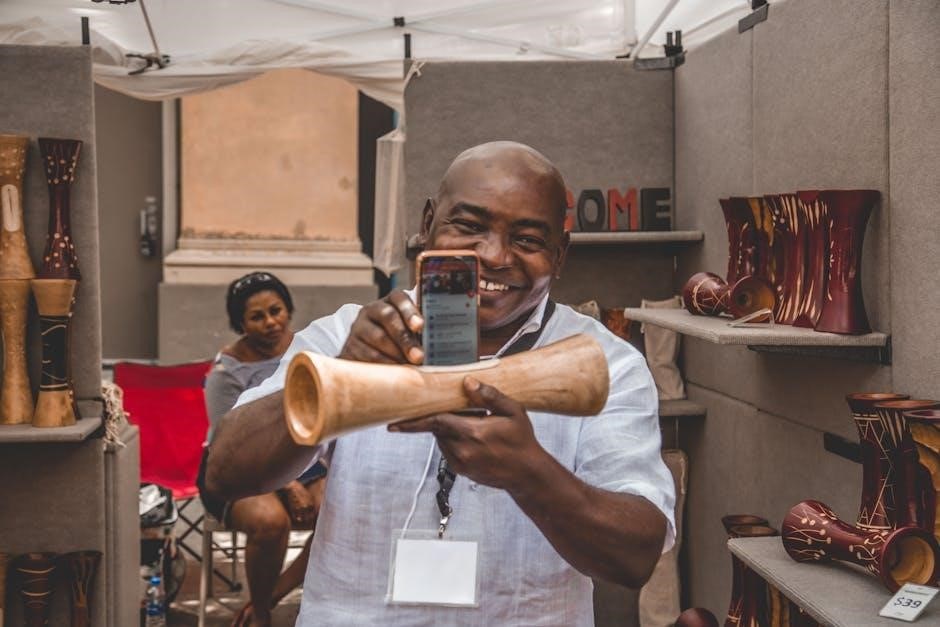Guided Path Counseling is a structured approach offering personalized support in education‚ mental health‚ and family services‚ helping individuals navigate life challenges and achieve goals․
Definition and Overview
Guided Path Counseling is a structured approach designed to help individuals navigate life challenges through personalized support․ It integrates technology to streamline the counseling process‚ offering tailored plans that address specific needs․ This method is widely applied in education‚ mental health‚ and family services‚ enabling clients to set and achieve realistic goals effectively․ By combining innovative tools with compassionate guidance‚ Guided Path Counseling ensures a focused and efficient journey toward personal growth and well-being․
Importance of Structured Counseling Approaches
Structured counseling approaches like Guided Path Counseling provide clarity and direction‚ ensuring consistent progress toward client goals․ These frameworks help counselors and clients stay focused‚ reducing ambiguity and enhancing accountability․ By organizing sessions and tracking milestones‚ structured approaches improve efficiency and client engagement․ They also allow for better integration of technology‚ such as progress-tracking tools‚ which support personalized care․ This method is particularly effective in addressing diverse needs‚ from mental health to education‚ ensuring a comprehensive and goal-oriented support system for individuals seeking guidance․

Key Components of Guided Path Counseling
Guided Path Counseling involves structured frameworks‚ technology integration‚ and personalized plans‚ ensuring tailored support for mental health‚ education‚ and personal growth through organized and adaptive strategies․

Structured Counseling Frameworks
Structured counseling frameworks provide a clear‚ organized approach to guiding individuals through challenges․ These frameworks ensure consistency and direction‚ making the counseling process efficient and goal-oriented․ By using predefined methods and tools‚ counselors can address specific needs‚ such as mental health support or educational guidance․ These frameworks also allow for adaptability‚ ensuring personalized attention while maintaining a coherent structure․ Examples include step-by-step plans for education or mental health‚ helping clients stay focused and motivated․ This approach fosters accountability and progress tracking‚ making it easier for individuals to achieve their objectives effectively․
Role of Technology in Counseling
Technology plays a pivotal role in modern counseling‚ enhancing accessibility and efficiency․ Telehealth platforms enable remote sessions‚ reaching individuals globally․ Software like GuidedPath streamlines student applications and progress tracking‚ while AI-driven tools offer personalized insights; Online portals facilitate secure communication and resource sharing․ Technology also supports data-driven approaches‚ allowing counselors to monitor progress and adjust plans in real-time․ Additionally‚ tools like Google Translate break language barriers‚ ensuring inclusive support․ These innovations empower counselors to deliver tailored services‚ making the counseling process more engaging and effective while maintaining confidentiality and client trust․
Personalized Counseling Plans
Personalized counseling plans are tailored to address individual needs‚ ensuring a focused and effective approach․ These plans are developed through initial assessments‚ identifying specific goals and challenges․ They incorporate diverse techniques‚ such as traditional psychotherapy‚ equine therapy‚ or specialized programs‚ to cater to unique circumstances․ Regular monitoring allows for adjustments‚ ensuring the plan remains relevant and impactful․ This customization fosters deeper engagement and progress‚ helping clients achieve meaningful outcomes․ Personalized plans empower individuals to address issues like anxiety‚ depression‚ or relationship problems with targeted strategies‚ promoting long-term well-being and personal growth․

Benefits of Guided Path Counseling
Guided Path Counseling offers tailored support‚ addressing anxiety‚ depression‚ and relationship issues‚ while reducing addiction symptoms and promoting mental health‚ leading to improved well-being and personal growth․
Improved Client Engagement
Guided Path Counseling enhances client engagement through structured‚ personalized approaches‚ fostering motivation and active participation․ By leveraging technology and interactive tools‚ clients gain clarity and ownership of their progress‚ leading to increased commitment and meaningful outcomes in addressing anxiety‚ depression‚ and relationship challenges․
Enhanced Goal-Setting Processes
Guided Path Counseling emphasizes structured frameworks to enhance goal-setting‚ ensuring objectives are clear‚ actionable‚ and aligned with client needs․ By incorporating personalized plans and technology‚ clients can break down goals into manageable steps‚ fostering accountability and progress tracking․ This approach motivates individuals to stay focused on their objectives‚ whether addressing mental health challenges or educational aspirations‚ leading to more effective and sustainable outcomes․
Streamlined Progress Tracking
Guided Path Counseling incorporates technology to streamline progress tracking‚ enabling real-time monitoring of client advancements․ Tools like telehealth platforms and specialized software allow counselors to track milestones effectively․ This structured approach ensures consistent follow-up‚ helping clients stay on course․ Regular assessments and data-driven insights enable timely adjustments to counseling plans‚ enhancing overall effectiveness․ By maintaining clear records and leveraging digital solutions‚ counselors can provide transparent and accountable support‚ fostering trust and motivation in the counseling journey․

Applications of Guided Path Counseling

Guided Path Counseling applies to education‚ mental health‚ and family services‚ empowering individuals to address challenges and achieve personal growth through structured‚ technology-integrated support systems․
Education and Career Guidance
Guided Path Counseling plays a pivotal role in education and career guidance by providing structured support for students and professionals․ It helps individuals set clear academic and career goals‚ explore pathways‚ and develop actionable plans․ The approach integrates technology‚ such as college counseling software‚ to streamline student applications and track progress․ Counselors work closely with clients to identify strengths‚ address challenges‚ and align aspirations with realistic opportunities․ This personalized guidance fosters confidence‚ resilience‚ and a sense of direction‚ enabling individuals to navigate educational and professional landscapes effectively․ It is particularly beneficial for those seeking clarity or transitioning between life stages․
Mental Health and Wellness
Guided Path Counseling offers compassionate support for mental health and wellness‚ addressing issues like anxiety‚ depression‚ trauma‚ and relationship challenges․ It provides a structured framework for individuals to explore their emotions‚ develop coping strategies‚ and work toward healing․ Counselors use evidence-based techniques to create personalized plans‚ fostering resilience and emotional well-being․ The approach emphasizes a collaborative relationship between client and counselor‚ ensuring a safe space for self-discovery and growth․ By focusing on holistic wellness‚ Guided Path Counseling helps individuals achieve balance‚ improve relationships‚ and enhance overall quality of life․ This tailored support is particularly beneficial for those navigating complex mental health journeys․
Special Needs and Support Services
Guided Path Counseling provides specialized support for individuals with special needs‚ addressing challenges such as addiction‚ co-occurring disorders‚ and behavioral issues․ The approach tailors counseling to meet unique requirements‚ ensuring personalized care for adolescents‚ children‚ and adults․ It emphasizes empowerment‚ helping clients develop skills to manage daily life and achieve stability․ By integrating structured frameworks and compassionate guidance‚ Guided Path Counseling fosters resilience and improves overall well-being․ This specialized support is designed to address complex needs‚ offering a pathway toward healing and long-term success for individuals facing specific challenges․
The Counseling Process
The counseling process involves a structured‚ guided approach to help individuals navigate challenges and achieve personal growth through tailored support and evidence-based strategies․

Initial Assessment and Evaluation
The initial assessment in guided path counseling involves gathering detailed information about the client’s background‚ challenges‚ and goals through interviews‚ surveys‚ and observations․ This step is crucial for understanding the individual’s unique needs and circumstances‚ allowing counselors to identify key areas requiring attention․ Technology‚ such as specialized software‚ may be used to streamline data collection and analysis․ The evaluation phase ensures a comprehensive understanding of the client’s strengths and limitations‚ forming the foundation for a personalized counseling plan․ This process is essential for establishing trust and aligning expectations‚ setting the stage for effective and targeted guidance throughout the counseling journey․
Setting Realistic and Achievable Goals
Setting realistic and achievable goals is a cornerstone of guided path counseling‚ ensuring clients have clear direction and motivation․ Counselors collaborate with clients to identify measurable objectives aligned with their values and aspirations․ These goals are tailored to individual needs‚ fostering a sense of purpose and accountability․ By breaking larger aspirations into smaller‚ manageable steps‚ clients can track progress and celebrate milestones‚ enhancing confidence and resilience․ This structured approach helps individuals stay focused and committed‚ ultimately empowering them to overcome challenges and achieve lasting success in their personal and professional lives․
Regular Monitoring and Adjustments
Regular monitoring and adjustments are essential in guided path counseling to ensure clients stay on track and adapt to changing needs․ Counselors use structured frameworks to review progress‚ identify challenges‚ and refine strategies․ This ongoing process fosters accountability and flexibility‚ allowing clients to adjust their goals and approaches as circumstances evolve․ Technology plays a key role‚ enabling real-time tracking and communication․ By continuously assessing and modifying plans‚ clients can overcome obstacles‚ maintain momentum‚ and achieve their objectives more effectively․ This dynamic approach ensures personalized support and maximizes the likelihood of long-term success․
Challenges and Limitations
Guided path counseling faces challenges like technological barriers‚ requiring trained professionals‚ and ensuring consistent client commitment‚ all impacting its effectiveness and accessibility․
Technological Barriers
Technological barriers pose significant challenges in guided path counseling‚ including limited internet access‚ compatibility issues with counseling software‚ and the need for stable connectivity for telehealth sessions․ Additionally‚ while tools like Google Translate facilitate communication across languages‚ they may struggle with nuanced expressions‚ potentially leading to misunderstandings․ The reliance on digital platforms also requires clients to have basic technical skills‚ which not all individuals possess․ Furthermore‚ the 10 MB limit for document translation can restrict the sharing of detailed records‚ creating inefficiencies․ Balancing technology’s benefits with these limitations remains crucial for ensuring equitable and effective counseling experiences․

Need for Trained Professionals
Guided path counseling requires highly trained professionals to effectively navigate its structured frameworks and personalized approaches․ Counselors must possess specialized training in mental health‚ education‚ and technology integration to deliver impactful support․ The complexity of addressing issues like anxiety‚ depression‚ and relationship problems demands expertise in evidence-based practices․ Additionally‚ professionals must stay updated on advancements in counseling software and telehealth tools to ensure seamless client interactions․ The need for skilled practitioners is further emphasized by the diverse client needs‚ ranging from adolescents to families‚ requiring tailored strategies․ Ensuring access to certified professionals remains a critical challenge in maximizing the benefits of guided path counseling․
Client Commitment and Participation
Client commitment and active participation are essential for the success of guided path counseling․ Engaged clients collaborate closely with counselors‚ fostering a collaborative environment that enhances goal achievement․ Regular attendance‚ open communication‚ and consistent effort are critical for progress․ Clients must take ownership of their growth‚ implementing strategies and reflecting on experiences․ Without commitment‚ the structured frameworks and personalized plans may not yield desired outcomes․ Encouraging client involvement ensures they remain motivated and invested in their journey‚ ultimately leading to lasting positive change and self-improvement․

Future of Guided Path Counseling
The future of guided path counseling lies in advancing technology‚ enhancing accessibility‚ and integrating mental health services for a more connected and supportive global community․
Advancements in Technology
Advancements in technology are revolutionizing guided path counseling by enhancing accessibility and personalization․ Tools like AI-driven assessments and telehealth platforms enable remote sessions‚ making counseling more convenient․ Software solutions‚ such as GuidedPath‚ streamline student applications and progress tracking‚ while Google Translate facilitates communication across languages․ These innovations improve engagement‚ simplify data analysis‚ and ensure consistent support․ As technology evolves‚ it empowers counselors to deliver more efficient and tailored services‚ addressing diverse needs globally․ The integration of technology not only expands reach but also strengthens the effectiveness of guided path counseling in education‚ mental health‚ and beyond․

Integration with Mental Health Services
Guided path counseling is increasingly integrated with mental health services to provide holistic support․ This approach addresses issues like anxiety‚ depression‚ and trauma by combining structured counseling frameworks with therapeutic interventions․ Centers like Guided Path Counseling in Sheboygan County and Wall Township offer specialized services for mental health‚ addiction‚ and co-occurring disorders․ By integrating mental health services‚ counselors can address underlying issues while helping clients achieve personal and educational goals․ This collaborative model ensures comprehensive care‚ making it easier for individuals to access the support they need in one cohesive program․
Expanding Accessibility Globally
Guided Path Counseling is expanding its reach globally‚ offering services in diverse regions like Alberta‚ Ontario‚ and Nova Scotia․ Telehealth platforms enable access to remote areas‚ ensuring mental health support for international clients․ This approach bridges gaps in care‚ adapting to local needs while maintaining structured frameworks․ By integrating technology and personalized care‚ Guided Path Counseling fosters inclusivity and cultural sensitivity‚ making mental health services more accessible worldwide․
Guided Path Counseling offers a transformative approach to mental health and personal growth‚ combining structured frameworks with compassionate support․ By leveraging technology and personalized plans‚ it addresses diverse challenges‚ from anxiety to addiction․ Its global expansion through telehealth ensures accessibility‚ making it a vital resource for individuals worldwide․ With a focus on empowerment and goal achievement‚ Guided Path Counseling continues to innovate‚ providing hope and guidance for a brighter future․




























































